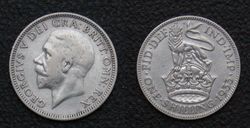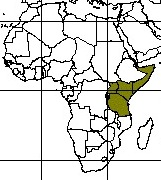Shilling

The shilling is a unit of currency used in some current and former British Commonwealth countries. The word shilling comes from schilling, an accounting term that dates back to Anglo-Saxon times where it was deemed to be the value of a cow in Kent or a sheep elsewhere. The word is thought to derive from the base skell-, "to ring/resound" and the diminutive suffix -ing. [1]
The abbreviation for shilling is s, from the Latin solidus, the name of a Roman coin. Often it was informally represented by a slash, standing for a Long s: e.g., "1/6d" meaning 1 shilling and sixpence (often pronounced "one and six"); a price with no pence was written with a slash and a dash, e.g., "11/–". Quite often a triangle or (serif) apostrophe would be used to give a neater appearance, e.g., "1'6" and "11'-". In Africa it is often abbreviated sh.

Contents |
United Kingdom
In the United Kingdom, a shilling was a coin used from the reign of Henry VII until decimalisation in 1971. Before decimalisation, there were 20 shillings/pound and 12 pence/shilling, and thus 240 pence/pound. Two coins denominated in multiple shillings were also in circulation at this time. They were the florin, which adopted the value of 10 new pence (10p), and the crown, the highest denominated non-bullion UK coin in circulation at decimalisation (in practice, crowns were commemorative coins not used in everyday transactions). At decimalisation, the shilling was superseded by the new 5 pence piece, which initially was of identical size and weight and had the same value, and inherited the shilling's slang name of a bob.
Irish shillings
In Ireland, the shilling was issued as scilling in Irish and was worth 1/20th of an Irish pound. The coin featured the bull on the obverse side. The original minting of the coin from 1928 until 1941 contained 75% silver; this Irish coin had a higher content than the equivalent British coin. The Irish shilling was finally withdrawn from circulation on January 1, 1993 as a smaller five pence coin was introduced.
Australian shillings
Australian shillings, twenty of which made up one Australian pound, were first issued in 1910, with the Australian coat of arms on the reverse and King Edward VII on the face. The coat of arms design was retained through the reign of King George V until a new ram's head design was introduced for the coins of King George VI. This design continued until the last year of issue in 1963. In 1966 Australia's currency was decimalised and the shilling was replaced by a ten cent coin (Australian), where 10 shillings made up one Australian dollar.
The slang term for a shilling coin in Australia was "deener". The slang term for a shilling as currency unit was "bob", the same as in the United Kingdom.

East African shillings
The East African shilling was in use in the British colonies and protectorates of British Somaliland, Kenya, Tanganyika, Uganda and Zanzibar from 1920, when it replaced the rupee, until after those countries became independent, and in Tanzania after that country was formed by the merger of Tanganyika and Zanzibar in 1964. Upon independence in 1960, the East African shilling in the State of Somaliland (former British Somaliland) and the Somali Somalo in the Southern Region (former Italian Somaliland) were replaced by the Somali Shilling.[2] In 1966 the East African Monetary Union broke up, and the member countries replaced their currencies with the Kenyan shilling, the Ugandan shilling and the Tanzanian shilling respectively.[3] Though all these currencies have different values at present, there were plans to reintroduce the East African shilling as a new common currency by 2009,[4] although this has not come about.
Somaliland shillings
The Somaliland shilling is the official currency of Somaliland, a de facto independent republic which is claimed in whole by Somalia. The Somaliland shilling, while stable, is not an internationally recognized currency and currently has no official exchange rate. It is regulated by the Bank of Somaliland, the central bank, which was established constitutionally in 1994. It was introduced on October 18, 1994 at one new Somaliland shilling to 100 Somali shillings. The Somali shilling ceased to be accepted as legal tender in Somaliland on January 31, 1995. It is an active and current currency.
Austrian shilling
The Austrian schilling was the currency of Austria between 1924 and 1938 and again between 1945 and 2002. It was replaced by the euro at a fixed parity of €1 = 13.7603 Schilling. The Schilling was divided into 100 Groschen.
Other countries' shillings

Shillings were also issued in New Zealand before decimalisation in the 1960s, in the Scandinavian countries (skilling) until the Scandinavian Monetary Union of 1873, and in the city of Hamburg, Germany.
The Sol (later the sou), both also derived from the Roman solidus, were the equivalent coins in France, while the (nuevo) sol (PEN) remains the currency of Peru. As in France, the Peruvian sol was originally named after the Roman solidus, but the name of the Peruvian currency is now much more closely linked to the Spanish word for the sun (sol). This helps explain the name of its temporary replacement, the inti, named for the Incan sun god.
Shillings were also used in Malta, prior to decimalization in 1972, and had a face value of five Maltese cents.
Elsewhere in the former British Empire, forms of the word shilling remain in informal use. In Vanuatu and Solomon Islands, selen is used in Bislama and Pijin to mean "money"; in Malaysia, syiling (pronounced like shilling) means "coin". In Egypt and Jordan the shillin (Arabic: شلن) is equal to 1/20th (5 qirshes (Arabic: قرش), piastres in English) of the Egyptian pound or the Jordanian dinar.
In the thirteen British colonies that became the United States in 1776, British money was often in circulation. Each colony issued its own paper money, with pounds, shillings, and pence used as the standard units of account. Some coins were minted in the colonies, such as the 1652 pine-tree shilling in the province of Massachusetts Bay. After the United States adopted the dollar as its unit of currency and accepted the gold standard, one British shilling was worth 24 U.S. cents. Due to ongoing shortages of U.S. coins in some regions, shillings continued to circulate well into the 1800s, for example being mentioned as the standard monetary unit throughout the autobiography of Solomon Northup.[5]
References
- ↑ shilling - Definitions from Dictionary.com
- ↑ Description of Somalia shilling - URL retrieved October 8, 2006
- ↑ Dissolution of the East African Monetary Union - URL retrieved October 8, 2006
- ↑ East African Business Council - Fact Sheet: Customs Union - URL Retrieved October 8, 2002
- ↑ Solomon Northup. Twelve Years A Slave. Auburn, Derby and Miller; Buffalo, Derby, Orton and Mulligan; [etc., etc.] 1853
External links
- The Shilling
- British Coins - Free information about British coins.